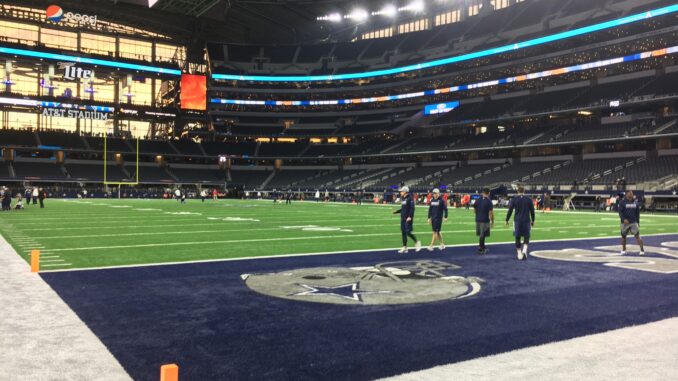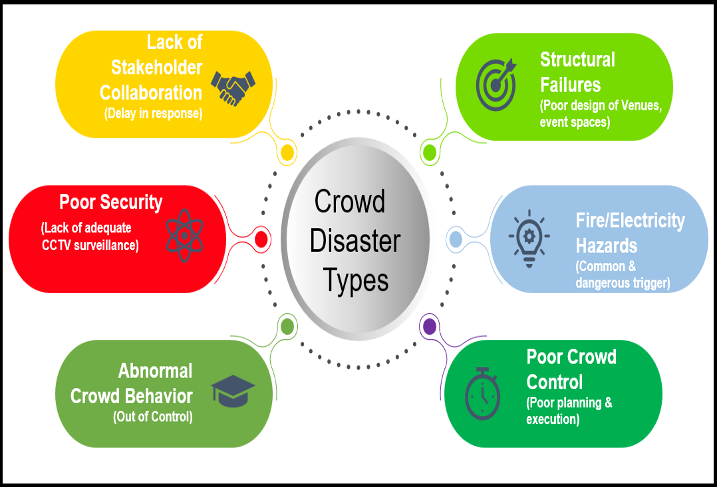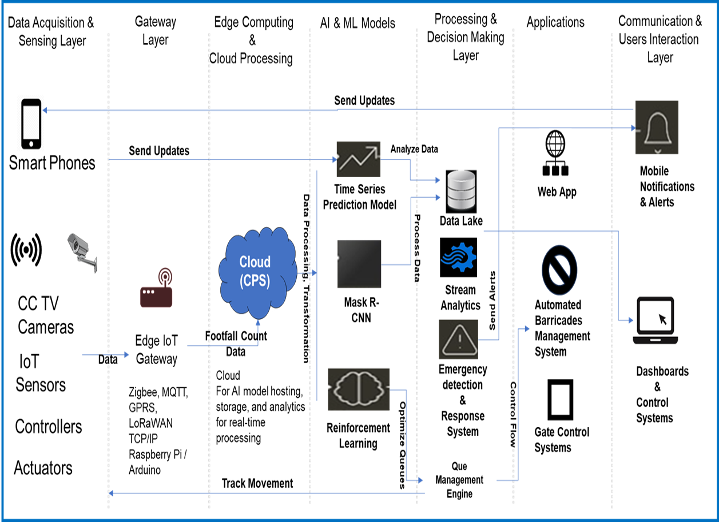
By Dr. Gopala Krishna Behara & Raja Sekhar Amirapu
Crowd disasters have become common across the world at religious pilgrimages, sport events and even at music concerts. These are dangerous, scary, resulting in senseless loss of life. Crowd disasters occur when the density of a crowd becomes too high. Various studies have repeatedly shown that, there is a risk of crowd injuries, when the crowd densities of five persons per square meter. If the density is seven people per square meter or more, the likelihood of death or serious injuries are high. Hence the crowd disasters are directly proportional to crowd densities. Having a proper Crowd Disaster Management is the need of hour.
Crowd Disaster Management entails systematic planning and execution of strategies aimed at ensuring the safety, order, and smooth movement of individuals in public areas, large assemblies, or events. This process requires collaboration among event organizers, emergency services, law enforcement, IT departments and other relevant parties to avoid overcrowding, reduce risks, and handle emergencies, all while improving the overall experience for participants.
As a result, it has become essential to develop an AI based National Crowd Disaster Management policy to address Crowd Crushes.
The objective of this article is to develop AI based solution for properly managing the crowd thereby enabling us to avoid any disaster. It covers Real-time Queue monitoring, Footfall prediction, Smart crowd distribution and Emergency Alerts.
Recent Incidents of Crowd Disasters
According to CBC News dated 16th February 2025 [1], A stampede occurred at the New Delhi Railway Station, resulting in at least 18 fatalities. The incident happened when a large crowd gathered to board a train to the Maha Kumbh festival.
As per Aljazeera dated 29th January [2], during the Mahakumbh Mela, the world’s largest religious festival, a crowd crush resulted in the deaths of at least 30 people. The stampede occurred as pilgrims rushed to participate in a sacred day of ritual bathing.
On 16th February, Outlook published that, at least six people died and 35 were injured in a stampede at the Lord Venkateswara Temple on Tirumala Hills in Andhra Pradesh on January 8, 2025. The chaos broke out as thousands of devotees rushed to get free passes for Vaikunta Dwara Darshanam [3].
Some of the earlier Crowd disasters [4] occurred throughout the world in recent years are,
- In November 2021, more than 10 people were killed in a crowd disaster at a live music concert in Houston, Texas, USA.
- In October 2022, a crowd crash in Itaewon, South Korea killed 159 people at Halloween festival
- In April 2023, nearly 90 people were killed in Sanna, Yemen at a charity distribution event.
- In December 2024, 35 people were killed at a religious festival in Nigeria.
- These examples are some of the samplings of type of catastrophe that happens very often than the people may think.
- In January 2022, a stampede at the Mata Vaishno Devi shrine in Katra, Jammu, killed 12 devotees and injured 15. The incident occurred around 2:45 am as a large crowd gathered for New Year darshan. According to sources, an argument among some young men led to pushing, triggering the stampede.
- On July 2, 2024 a massive crowd of 2.5 lakh devotees gathered in Phulari village, Hathras, for a religious sermon by ‘Bhole Baba,’ a former policeman-turned-preacher with a strong following in western Uttar Pradesh. A deadly stampede broke out, killing 116 people in one of the worst such tragedies in recent years. The Baba later blamed “anti-social elements” for the chaos.
- More than 400 people died on a single day of the festival in 1954 after being trampled or drowned, in what remains one of the deadliest incidents of its kind.
Challenges of Crowd Disaster
The causes of Crowd Disasters are broadly classified into six categories [5] based on reports and websites across the world. They are, Structural, Fire/Electricity, Crowd Control, Crowd Behavior, Security, and Lack of coordination between various stakeholders.
The following diagram depicts the challenges of Crowd Disaster.

Fig 1: Types of Crowd Disasters
- Structural Failures: When venues or event spaces are not adequately designed or maintained, structural failures can occur. Main categories of structural failures are, collapse of unauthorized structures, narrow pathways, absence of emergency exits, or difficult terrains.
- Fire/Electricity Hazards: Fires and associated electrical hazards represent a common and dangerous trigger for crowd disasters. Poor wiring, Building and fire code violations, non-availability of fire extinguisher/fire extinguishers not in working condition, Illegal electric connections are some of the examples of crowd disasters.
- Poor Crowd Control: Overcrowding, insufficient staffing, sudden opening of entry doors, closed or locked exits, and poor event planning contribute to hazardous conditions. Main cause is that more than anticipated crowd at store/mall/political rallies/ examinations/ religious gatherings/ public celebrations.
- Abnormal Crowd Behavior: Unruly behavior of the crowd during panic situations. A wild rush to force the way towards entrance/exits, Crowds attempting to enter a venue after the start/closing time, A collision between large inward flows and outward flows, Rush during distribution of disaster relief supplies, many pilgrims trying to board a ferry for a sacred island site, Free distribution of needs, triggering a surge and crush, Tussle to catching.
- Poor Security: A breakdown in security measures can significantly increase the risk of a crowd disaster. When there are insufficiently trained or too few security personnel on site, or when surveillance systems fail to detect early signs of distress, the situation can deteriorate quickly.
- Lack of Stakeholder Collaboration: Effective crowd management relies on seamless coordination among various agencies like event organizers, law enforcement, emergency services, and local government. When there are gaps in communication or collaboration, delays in response and resource allocation.
Crowd Disaster Management Process Model
The Crowd Disaster Management process involves various steps including capacity planning, understanding the crowd behavior, stakeholder collaboration, risk estimation and preparedness, Information dissemination, security and safety measures, execution, and continuous improvement. The brief description of the steps is explained below,
- Capacity Planning: Ensure the venue can accommodate the expected crowd size.
- Understanding Crowd Behavior: Anticipate crowd movements and potential triggers for panic.
- Stakeholder Coordination: Collaborate with event organizers, emergency services, law enforcement, and other stakeholders.
- Risk Estimation and Preparedness: Identify potential threats and develop mitigation strategies.
- Information Dissemination: Provide clear and timely information to attendees through various channels.
- Security and Safety Measures: Implement robust security protocols and ensure the availability of medical emergency services.
The following diagram explains the solution proposed for the Integrated Crowd Management System.

Fig 2: Process Flow of Integrated Crowd Management System
In this integrated crowd management system, the process begins with a Participant whose movement and crowd data are sent to IoT sensors, while simultaneously, CCTV cameras equipped with AI capture and process footfall counts.
The IoT sensors transmit real-time density updates to a centralized Cloud Backend, which aggregates this information with the processed data from the CCTV AI.
Cloud Backend uses these insights to send waiting times and alternative route suggestions to a Mobile App, ensuring that devotees receive timely navigation assistance. Concurrently, the Cloud Backend provides real-time analytics and generates alerts for overcrowding and emergencies,
Admin Dashboard performs continual monitoring and decision-making. From this dashboard, updated queue settings and response plans are communicated back to the Cloud Backend, and subsequent queue updates and notifications are forwarded to the Mobile App.
In parallel, the system dynamically adjusts crowd paths through the control of Automated Barricades, thereby optimizing the flow and ensuring enhanced safety during the event.
Crowd Disaster Management – High Level Architecture
The following diagram depicts the Crowd Disaster Management Contextual Architecture developed using cutting edge technologies such as IoT, AI, and cloud computing to ensure safety, efficiency, and a positive experience for all attendees.

Fig 3: Crowd Disaster Management Reference Architecture
Participants: represent the individual attendees in the crowd. They are the source of the primary data input for the Crowd Disaster Management System. The system continuously monitors the movement and behavior of the participants.
Smartphones: These are carried by the crowd and act as data sources, transmitting real-time location and movement information through applications.
IoT Sensors: IoT Sensors and devices help to gather real-time data form different locations of the event area covering crowd density, crowd movement, crowd behavior, inflow and outflow of the crowd and traffic and other environmental factors. These sensors capture critical metrics and send the movement and crowd data to the CDMS for further analysis.
CCTV Cameras: These are enabled with AI capabilities and provide crowd visual data. They help with analyzing footage in real-time. The AI can identify crowd movement patterns, recognize faces, count people, and detect unusual behavior or potential hazards. The collected data is transmitted to the Cloud central processing system.
Cloud: The Cloud serves as the central processing unit of the system. It receives real-time cloud density updates from IoT sensors and processed footfall count data from CCTV. The Cloud analyzes this information to generate insights and alerts.
Time Series Prediction Model: It helps in forecasting crowd behavior and dynamics based on historical and real-time data. It analyzes patterns in crowd density, movement, and environmental data to predict potential crowding or bottlenecks over time. This model forecasts the crowd density and its threshold values in real time to help the administrators to act in real-time and take corrective measures.
Mask R-CNN: It’s called Region-Based Convolutional Neural Network used to detect people or barriers within images or videos for real-time analysis. Mask R-CNN helps in counting individuals accurately by segmenting each person from video feeds, helping estimate real-time crowd density. It performs real-time analysis of surveillance footage to detect risky crowd behaviors, fallen individuals, aggressive movements, or clustering patterns that might indicate panic or distress.
Reinforcement Learning: These algorithms learn from past incidents and handle optimal crowd flow routes by considering real-time data, crowd density, and potential risks. For example, it can suggest alternative evacuation paths during emergencies. It also manages systems like automated barricades, gates, or entry points to regulate flow dynamically based on current conditions.
Queue Management Engine: It is responsible for optimizing the flow of people. It processes data from various sources to determine the best strategies for managing queues, controlling access, and preventing overcrowding.
Automated Barricades Management System: This system dynamically adjusts paths and controls the flow of crowd based on real-time data. These barricades are automatically controlled by the Admin Dashboard and the Queue Management Engine to ensure safe and efficient movement.
Mobile Application: The Mobile Application is used by Participants to receive real-time updates on waiting times, alternative routes, and other critical information. It communicates with the Cloud to ensure that users are informed and guided effectively.
Dashboards: The consumers of this dashboard are event organizers and security personnel. It acts like a control center. It displays real-time analytics, alerts for overcrowding and emergencies, and allows administrators to update queue settings and response plans. The Admin Dashboard receives data from the Cloud Central Processing System and AI-powered queue management systems.
The system generates maps and alerts for dissemination to local authorities and the public, offering them crucial time to prepare and respond.
Conclusion
Crowd disasters are technically well understood, easy to predict and inexpensive to prevent. The solution based on AI and ML, IoT helps in prediction, monitoring, decision making and communication. AI-powered cameras and sensors monitor crowd density and behavior, providing real-time insights to government authorities and event organizers.
These technologies help ensure the safety and well-being of people during large gatherings and events.
Federal Governments, State Governments, Event Organizers need to leverage these types of solutions to keep the crowd safe.
References
- https://www.cbc.ca/news/world/india-delhi-railway-stampede-1.7460665?form=MG0AV3
- https://www.aljazeera.com/news/2025/1/29/several-reported-killed-in-crush-at-religious-festival-in-india?form=MG0AV3&form=MG0AV3
- https://www.outlookindia.com/national/from-kumbh-to-hathras-stampede-disasters-in-recent-years?form=MG0AV3&form=MG0AV3
- https://apnews.com/article/major-crowd-disasters-e9d9ac155629b5b19b70b05a3cf910b1
- https://www.gkstill.com/ExpertWitness/CrowdDisasters.html
Acknowledgements
The authors would like to thank Tanay Srivastava, Director, Tricon Solutions LLC for giving the required time and support in many ways in bringing up this Comprehensive Guide as part of Technical Services efforts.
About Authors
Dr. Gopala Krishna Behara is an Enterprise Architect at Tricon Solutions LLC. He has around 28 years of IT experience. He can be reached at gopalakrishna.behara@triconitsolutions.com.
Raja Sekhar Amirapu is a Senior Architect at Coforge. He has a total of 26 years of IT experience. He can be reached at raja.amirapu@gmail.com
Disclaimer
The views expressed in this article/presentation are those of authors and Tricon Solutions LLC & Coforge does not subscribe to the substance, veracity or truthfulness of the said opinion.
